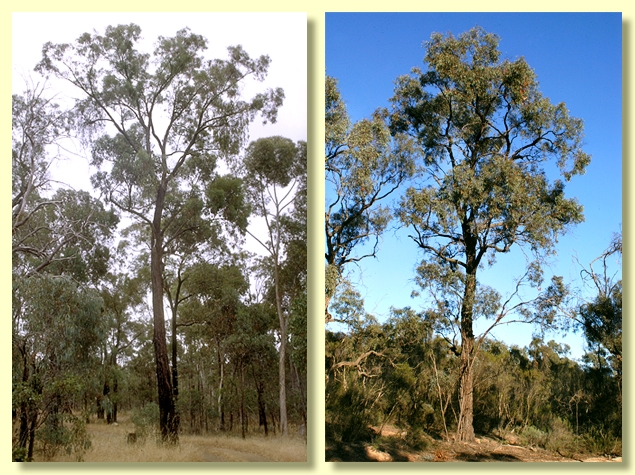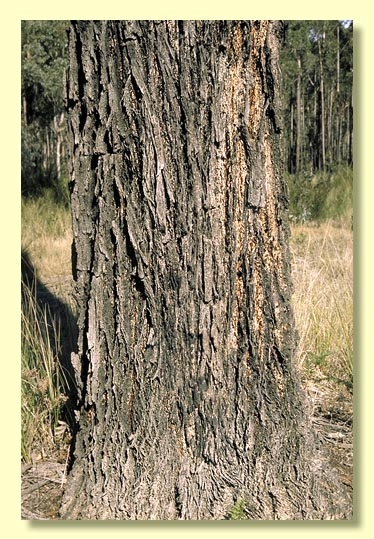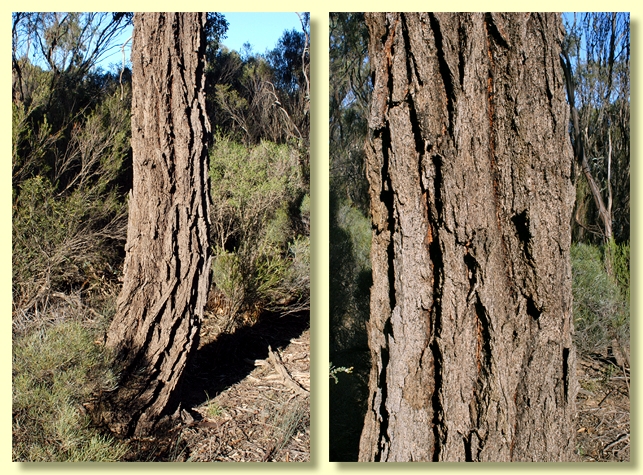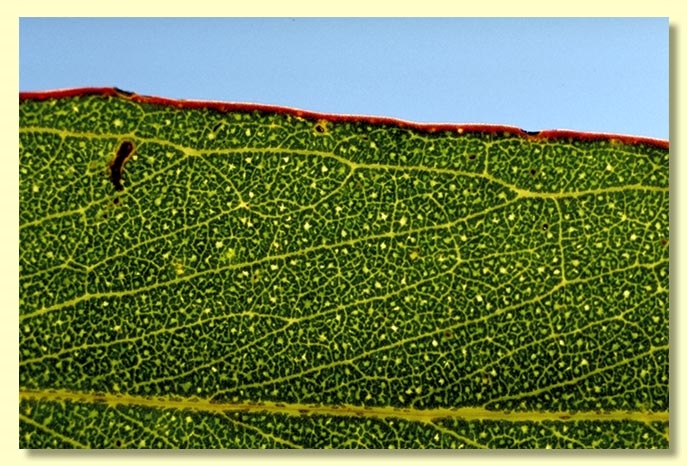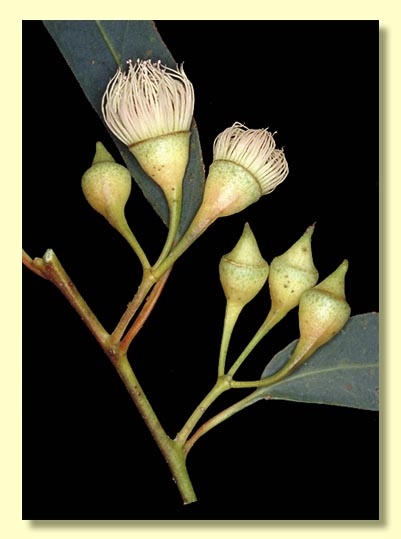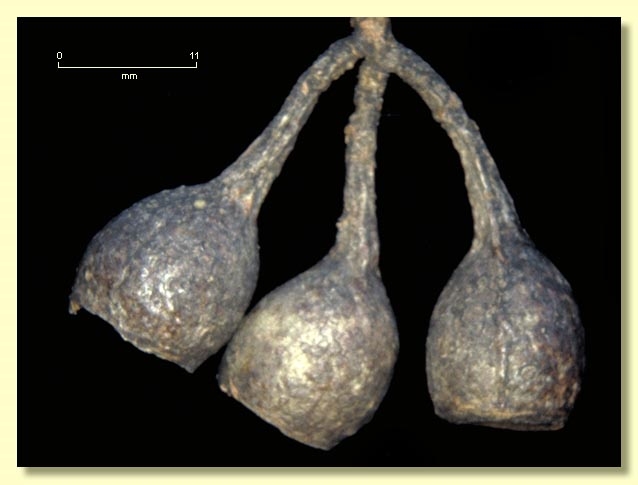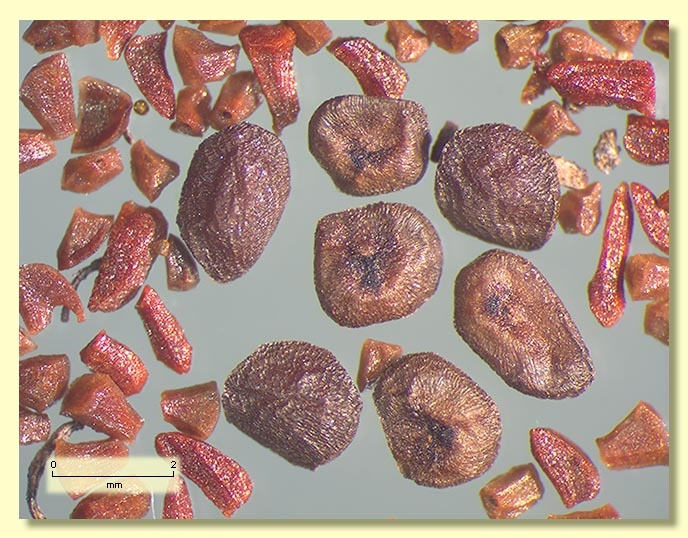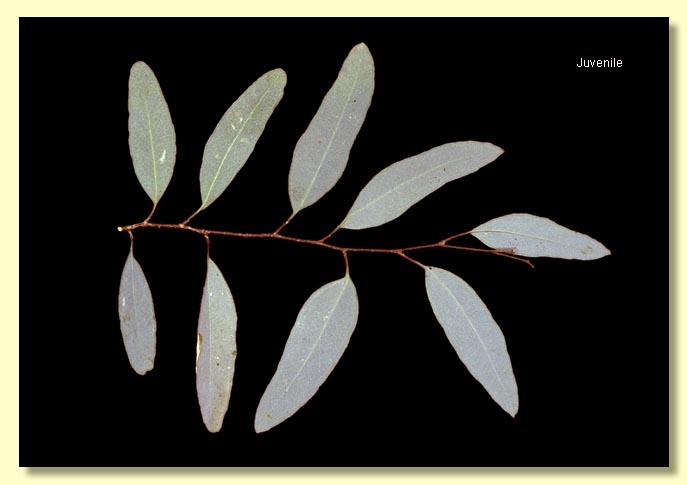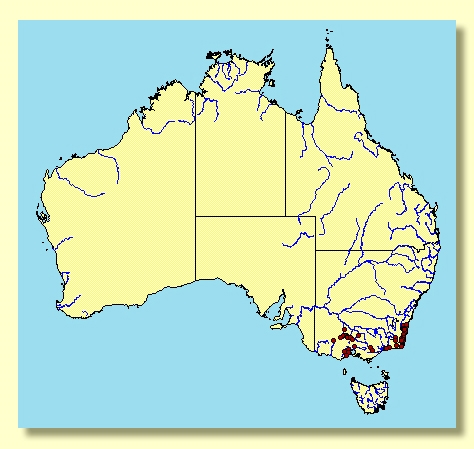Euclid - Online edition
Eucalyptus tricarpa
Eucalyptus | Symphyomyrtus | Adnataria | Terminales | Melliodorae | Solidae
Eucalyptus sideroxylon subsp. tricarpa L.A.S.Johnson, Contr. New South Wales Natl Herb. 3: 122 (1962). T: Tilba Tilba to Wallaga Lake, NSW, 20 Nov. 1950, L.A.S.Johnson NSW 54090; holo: NSW.
Eucalyptus tricarpa subsp. decora K.Rule, Muelleria 20: 27 (2004). T: Victoria: Sunraysia Highway, 42.4 km S of the southern roundabout, St Arnaud, 10 May 2002, K. Rule 0250; holo: MEL iso: AD, CANB, NSW.
Ironbark to small branches, dark grey to black, deeply furrowed, thick and hard.
Juvenile growth (coppice or field seedlings to 50 cm): stem rounded in cross-section; juvenile leaves always petiolate, opposite for 5 to 7 nodes then alternate, elliptical to lanceolate, 4–11 cm long, 1.3–3 cm wide, base tapering to petiole, green to grey-green.
Adult leaves alternate, petiole 1–3 cm long; blade lanceolate to falcate, 8–22 cm long, 1–2.6 cm wide, base tapering to petiole, concolorous, glossy or dull, green to grey-green or glaucous, side veins acute, densely reticulate, intramarginal vein parallel to and remote from margin (sometimes double), oil glands mostly intersectional.
Inflorescence axillary unbranched, peduncle often pendulous, 0.5–1.8 cm long, buds 3 per umbel or on some plants mixed with umbels of 7, pedicels 0.5–1.8 cm long. Mature buds ovoid, 1–1.5 cm long, 0.6–0.9 cm wide, green to creamy (flushed with pink), scar absent, operculum conical to beaked, stamens inflexed, with outer staminodes, anthers adnate, positioned obliquely at filament tip, cuboid, dehiscing by terminal pores, style long, stigma pin-head shaped, locules 4 to 7, the placentae each with 4 vertical ovule rows. Flowers white or pale pink.
Fruit on pedicels 0.5–2 cm long, cylindrical to truncate-globose, 0.8–1.3 cm long, 0.8–1.5 cm wide, disc descending, staminophore broad and deciduous, valves 4 to 7, enclosed.
Seeds brown or grey, 1–2 mm long, ovoid or flattened-ovoid, often pointed at one end, sometimes lacunose, dorsal surface shallowly pitted, hilum ventral.
Cultivated seedlings (measured at ca node 10): cotyledons reniform to oblong; stems square to rounded in cross-section; leaves petiolate, opposite for 6 or 7 pairs, lanceolate, 4–11 cm long, 0.7–4 cm wide, base tapering, margin entire, apex rounded to pointed, concolorous, grey-green to green.
Flowering has been recorded in February, March, April, June, July, August, September, October and November.
A small to tall forest tree of south coastal New South Wales south from Araluen and Burrewurra Point, to coastal and subcoastal areas of Victoria, in Gippsland east from Genoa River, Nowa Nowa, Toongabbie, Licola, the You Yangs, Anglesea and common in the goldfields around Whroo, Bendigo, Wedderburn and Stawell. An ironbark, it is close to E. sideroxylon but differs most conspicuously by the three-budded inflorescences (E. sideroxylon with seven-budded inflorecences) and to a lesser extent by the larger buds and fruit. Intermediates between E. tricarpa and E. sideroxylon with buds in threes and sevens occur in some populations, e.g. Mt Nowa Nowa in Gippsland and Ben Boyd National Park near Eden. Flowers are white, rarely pink.
A population near Bealiba in central Victoria has very glaucous forms mixed with more typical green-leaved forms. The taxon Eucalyptus tricarpa subsp. decora was recently described to accomodate these glaucous forms. However, glaucous and non-glaucous forms grow together and degrees of glaucescence are obvious in the field, and individuals seemingly non-glaucous when fresh may appear glaucous when dried as specimens. Consequently this new name is not helpful and is placed in synonymy.
Eucalyptus tricarpa and E. sideroxylon differ from all other ironbarks by the retention of the outer operculum until flowering.
In the classification of Brooker (2000) Eucalyptus tricarpa is in subgenus Symphyomyrtus section Adnataria because the buds have two opercula, ovules are in four rows, seeds are flattened-ovoid, cotyledons are reniform, and anthers are rigid on the staminal filaments. Within section Adnataria, E. tricarpa is part of a small subgroup, series Melliodorae, further characterised by having buds in axillary clusters, the outer operculum being retained until flowering when both opercula are shed together, and the flowers having outer stamens that are sterile whilst inner stamens are fertile, and a broad staminal ring that can often be seen on the fuit but ultimately is deciduous. The 5 species in series Melliodorae are E. sideroxylon, E. tricarpa, E. melliodora, E. leucoxylon (with 4 subspecies) and E. petiolaris.
MORE ABOUT IRONBARKS

